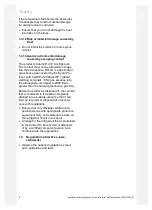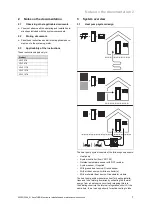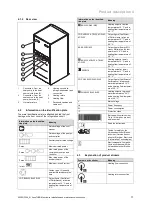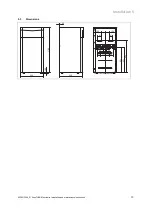
8 Electrical installation
20
Installation and maintenance instructions flexoTHERM exclusive 0020213394_01
Caution.
Risk of material damage caused by an
incorrect filling direction.
If you fill the brine pump against the direction
of flow, this may lead to a turbine effect which
can damage the pump's electronics.
▶
Ensure that the brine pump is filled in the
direction of flow.
7.
Use the filling pump
(67)
to pour the brine fluid from the
brine container
(66)
into the brine circuit.
7.2.3
Purging the brine circuit
1.
Start up the filling pump
(67)
in order to fill and rinse the
brine circuit.
2.
Allow the filling pump
(67)
to run for at least 10 minutes
in order to fill and rinse the circuit sufficiently.
3.
Then close the stop valves
(61)
and
(62)
and switch off
the filling pump
(67)
.
4.
If required, repeat this rinsing process.
5.
Open the stop valve
(63)
.
7.2.4
Building up pressure in the brine circuit
1.
Use the filling pump
(67)
to pressurise the brine circuit.
Note
To operate the brine circuit without any prob-
lems, a filling pressure of 0.17 MPa (1.7 bar)
is required. The expansion relief valve opens
at 0.3 MPa (3 bar).
2.
Read off the pressure on a pressure gauge (on-site).
–
Brine fluid operating pressure range: 0.07
… 0.20 MPa (0.70 … 2.00 bar)
3.
Build up the pressure in the brine circuit by opening the
stop valve
(62)
and using the filling pump to top up the
brine fluid.
4.
If required, reduce the pressure in the brine circuit by
opening the stop valve
(61)
to drain brine fluid.
5.
Check the brine circuit's filling pressure in the heat
pump's display.
6.
If required, repeat the process.
7.
Remove the two hoses from the valves
(61)
and
(62)
.
8.
Purge the system once more after starting up the heat
pump.
9.
Label the container that holds the remaining brine fluid
with information about the type of brine fluid and the set
concentration.
10. Pass the vessel with the remaining brine fluid on to
the operator to be stored. Point out to the operator that
there is a risk of injury when handling brine fluid.
8
Electrical installation
Danger!
Risk of death from electric shock caused
by a residual-current circuit breaker not
working.
In certain cases, residual-current circuit
breakers may not work.
▶
If residual-current circuit breakers are re-
quired to ensure that people are protec-
ted and fire is prevented in line with the
applicable standards, use type A pulse-
current-sensitive residual-current circuit
breakers or type B universal-current-sens-
itive residual-current circuit breakers.
▶
Observe the technical connection conditions for connect-
ing to the power supply network operator's low-voltage
network.
▶
Use the values for the maximum rated power that are
specified in the technical data to determine the required
line cross-sections.
▶
In each case, take into consideration the (on-site) install-
ation conditions.
▶
Connect the product using a fixed connection and an
electrical partition with a contact opening of at least 3 mm
(e.g. fuses or power switches).
▶
Install the electrical partition right next to the heat pump.
▶
For the electricity supply, in accordance with the identi-
fication plate, connect the product, in phase, to a three-
phase 400 V AC network with a neutral line and an earth
line.
▶
Fuse this connection using the exact values that are spe-
cified in the technical data.
▶
If the local power supply network operator requires that
the heat pump is controlled using a blocking signal, fit a
corresponding contact switch as prescribed by the power
supply network operator.
▶
Ensure that the sensor lines, e. g. for the VRC DCF re-
ceiver, do not exceed the maximum line length of 50 m.
▶
At lengths of 10 m or more, mains voltage supply lines
must be laid separately from sensor or bus lines. Min-
imum clearance for the extra-low voltage and mains
voltage line at a line length of > 10 m: 25 cm. If this is not
possible, use shielded lines. Lay the shielding on one
side of the sheet for the product's electronics box.
▶
Do not use free terminals on the heat pump as base ter-
minals for further wiring.
30 mm max.
1
2
1
Connecting wires
2
Insulation
▶
Only strip a maximum of 3 cm from the outer sheathing of
the flexible lines.
▶
Secure the conductors in the connection terminals.
















































